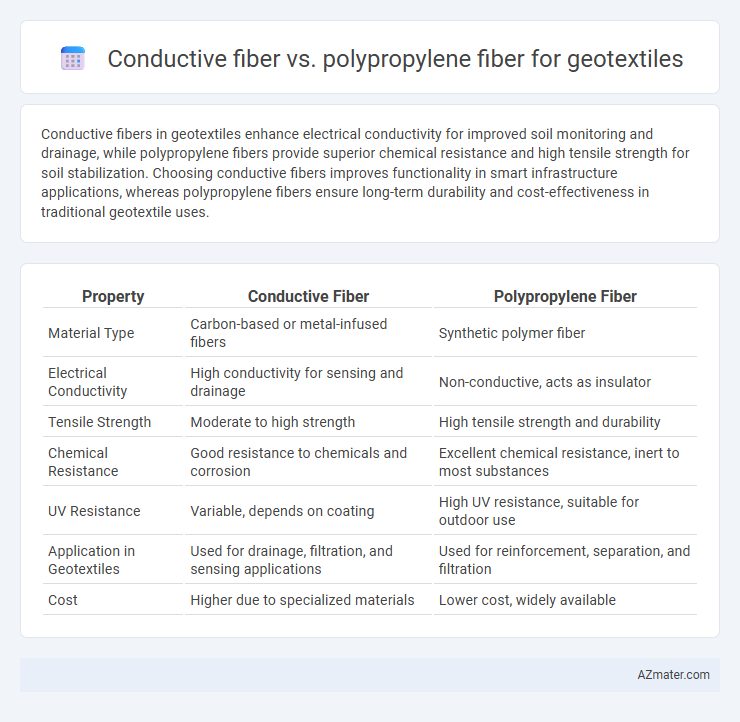Conductive fibers in geotextiles enhance electrical conductivity for improved soil monitoring and drainage, while polypropylene fibers provide superior chemical resistance and high tensile strength for soil stabilization. Choosing conductive fibers improves functionality in smart infrastructure applications, whereas polypropylene fibers ensure long-term durability and cost-effectiveness in traditional geotextile uses.
Table of Comparison
| Property | Conductive Fiber | Polypropylene Fiber |
|---|---|---|
| Material Type | Carbon-based or metal-infused fibers | Synthetic polymer fiber |
| Electrical Conductivity | High conductivity for sensing and drainage | Non-conductive, acts as insulator |
| Tensile Strength | Moderate to high strength | High tensile strength and durability |
| Chemical Resistance | Good resistance to chemicals and corrosion | Excellent chemical resistance, inert to most substances |
| UV Resistance | Variable, depends on coating | High UV resistance, suitable for outdoor use |
| Application in Geotextiles | Used for drainage, filtration, and sensing applications | Used for reinforcement, separation, and filtration |
| Cost | Higher due to specialized materials | Lower cost, widely available |
Introduction to Geotextiles: Functions and Applications
Conductive fibers in geotextiles enhance electrical conductivity, enabling applications such as soil moisture monitoring and electromagnetic interference shielding, while polypropylene fibers mainly provide high tensile strength, chemical resistance, and durability for soil stabilization and erosion control. Polypropylene's lightweight and hydrophobic properties make it ideal for filtration and separation tasks in civil engineering projects. The choice between conductive and polypropylene fibers depends on specific geotextile functions like reinforcement, drainage, filtration, or smart sensing in infrastructure development.
Overview of Conductive Fiber in Geotextiles
Conductive fibers in geotextiles are engineered to enhance electrical conductivity and facilitate monitoring or drainage functions in soil stabilization and infrastructure projects. These fibers often consist of carbon-based or metallic materials embedded within the geotextile matrix, improving their performance in applications like leakage detection and electromagnetic shielding. Compared to polypropylene fibers, conductive fibers provide advanced functionalities beyond mechanical reinforcement, making them ideal for smart geotextile systems used in modern civil engineering.
Polypropylene Fiber: Properties and Uses in Geotextiles
Polypropylene fiber exhibits high tensile strength, resistance to chemical degradation, and excellent durability in geotextile applications, making it an ideal choice for soil stabilization, erosion control, and drainage systems. Its hydrophobic nature ensures minimal water absorption, enhancing persistence against biological and chemical agents in harsh environmental conditions. Compared to conductive fiber, polypropylene fiber offers superior chemical inertness and cost-effectiveness, widely utilized in road construction, landfill liners, and filtration layers.
Mechanical Strength Comparison: Conductive vs Polypropylene Fiber
Conductive fibers in geotextiles typically offer enhanced mechanical strength due to their composition, which often includes carbon or metal-based materials, providing superior tensile strength and durability compared to polypropylene fibers. Polypropylene fibers are prized for their chemical resistance and lightweight nature but generally exhibit lower tensile strength and elongation at break than conductive fibers. In applications requiring high mechanical performance, conductive fiber geotextiles demonstrate better load-bearing capacity and long-term resilience under stress conditions.
Electrical Conductivity in Geotextile Applications
Conductive fibers exhibit significantly higher electrical conductivity compared to polypropylene fibers, making them ideal for geotextile applications requiring electrical signal transmission or electromagnetic interference shielding. Polypropylene fibers offer excellent chemical resistance and mechanical strength but are electrically insulating, limiting their use in applications where conductivity is critical. Incorporating conductive fibers enhances functionalities such as real-time structural health monitoring and effective lightning protection in geotextile installations.
Chemical Resistance and Durability
Conductive fibers in geotextiles exhibit superior chemical resistance, particularly against acids, alkalis, and solvents, compared to polypropylene fibers, which may degrade over time when exposed to harsh chemicals. Durability of conductive fibers is enhanced by their inherent electrical conductivity and robust molecular structure, enabling longer service life in aggressive environmental conditions. Polypropylene fibers offer good mechanical strength and resistance to biological degradation but generally fall short in chemical resistance and long-term durability under chemically aggressive scenarios.
Water Permeability and Filtration Efficiency
Conductive fibers in geotextiles offer enhanced water permeability due to their porous structure, facilitating efficient drainage and reducing water retention, which is critical for erosion control and soil stabilization. Polypropylene fibers exhibit high filtration efficiency by effectively trapping fine soil particles while maintaining sufficient permeability, making them ideal for sediment control in geotechnical applications. Comparing both, conductive fibers optimize conductive pathways for moisture movement, whereas polypropylene fibers balance durability with selective filtration, impacting overall geotextile performance in water management systems.
Environmental Impact and Sustainability
Conductive fibers in geotextiles, often made from carbon-based or metal-infused materials, offer enhanced durability but pose challenges in biodegradability and recycling compared to polypropylene fibers, which are synthetic, lightweight, and resistant to chemical degradation. Polypropylene fibers, widely used in geotextile applications, demonstrate lower environmental impact due to their recyclability and longer lifecycle, though their production relies on fossil fuels, influencing sustainability metrics. Selecting between conductive and polypropylene fibers requires balancing performance needs with environmental considerations, emphasizing the importance of lifecycle assessments and material recovery potential in sustainable geotextile design.
Cost Analysis: Conductive Fiber vs Polypropylene Fiber
Conductive fibers typically incur higher material and manufacturing costs compared to polypropylene fibers due to their specialized raw materials and production processes. Polypropylene fibers offer a cost-effective solution with lower price per unit length and widespread availability, making them economically favorable for large-scale geotextile applications. When evaluating long-term project budgets, the initial premium of conductive fibers may be justifiable by their enhanced functionality, whereas polypropylene fibers are chosen primarily for budget-sensitive projects requiring standard performance.
Which Fiber is Best for Your Geotextile Project?
Conductive fiber in geotextiles offers superior electrical conductivity and durability, making it ideal for projects requiring enhanced drainage and monitoring capabilities. Polypropylene fiber provides excellent chemical resistance, lightweight properties, and cost-effectiveness, suitable for general filtration and separation applications. Choosing the best fiber depends on project-specific needs such as electrical performance versus chemical and UV resistance.

Infographic: Conductive fiber vs Polypropylene fiber for Geotextile
 azmater.com
azmater.com